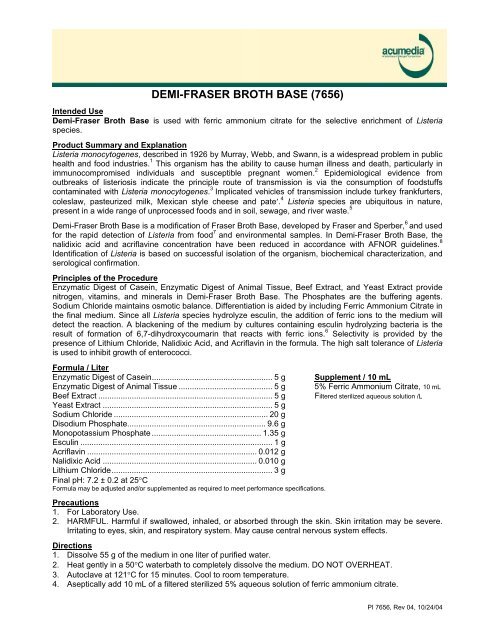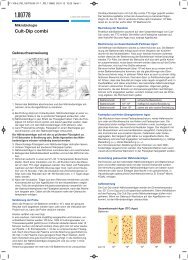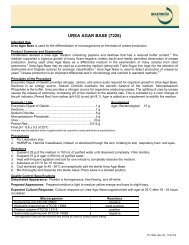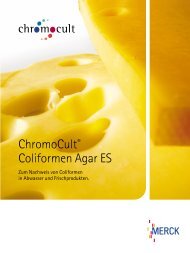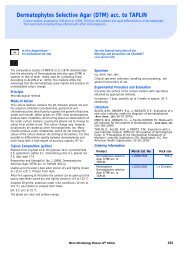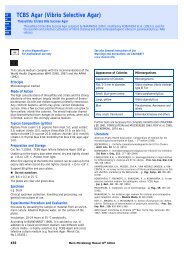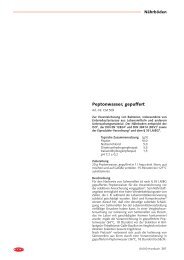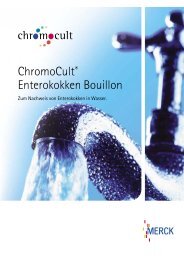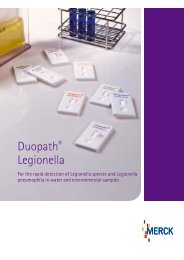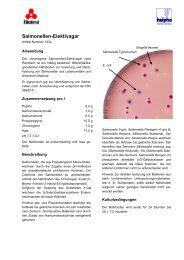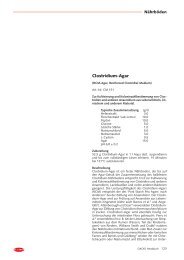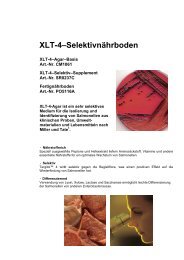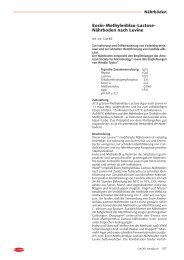Demi-Fraser Broth Base (7656) - mibius
Demi-Fraser Broth Base (7656) - mibius
Demi-Fraser Broth Base (7656) - mibius
You also want an ePaper? Increase the reach of your titles
YUMPU automatically turns print PDFs into web optimized ePapers that Google loves.
DEMI-FRASER BROTH BASE (<strong>7656</strong>)<br />
Intended Use<br />
<strong>Demi</strong>-<strong>Fraser</strong> <strong>Broth</strong> <strong>Base</strong> is used with ferric ammonium citrate for the selective enrichment of Listeria<br />
species.<br />
Product Summary and Explanation<br />
Listeria monocytogenes, described in 1926 by Murray, Webb, and Swann, is a widespread problem in public<br />
health and food industries. 1 This organism has the ability to cause human illness and death, particularly in<br />
immunocompromised individuals and susceptible pregnant women. 2 Epidemiological evidence from<br />
outbreaks of listeriosis indicate the principle route of transmission is via the consumption of foodstuffs<br />
contaminated with Listeria monocytogenes. 3 Implicated vehicles of transmission include turkey frankfurters,<br />
coleslaw, pasteurized milk, Mexican style cheese and pate′. 4 Listeria species are ubiquitous in nature,<br />
present in a wide range of unprocessed foods and in soil, sewage, and river waste. 5<br />
<strong>Demi</strong>-<strong>Fraser</strong> <strong>Broth</strong> <strong>Base</strong> is a modification of <strong>Fraser</strong> <strong>Broth</strong> <strong>Base</strong>, developed by <strong>Fraser</strong> and Sperber, 6 and used<br />
for the rapid detection of Listeria from food 7 and environmental samples. In <strong>Demi</strong>-<strong>Fraser</strong> <strong>Broth</strong> <strong>Base</strong>, the<br />
nalidixic acid and acriflavine concentration have been reduced in accordance with AFNOR guidelines. 8<br />
Identification of Listeria is based on successful isolation of the organism, biochemical characterization, and<br />
serological confirmation.<br />
Principles of the Procedure<br />
Enzymatic Digest of Casein, Enzymatic Digest of Animal Tissue, Beef Extract, and Yeast Extract provide<br />
nitrogen, vitamins, and minerals in <strong>Demi</strong>-<strong>Fraser</strong> <strong>Broth</strong> <strong>Base</strong>. The Phosphates are the buffering agents.<br />
Sodium Chloride maintains osmotic balance. Differentiation is aided by including Ferric Ammonium Citrate in<br />
the final medium. Since all Listeria species hydrolyze esculin, the addition of ferric ions to the medium will<br />
detect the reaction. A blackening of the medium by cultures containing esculin hydrolyzing bacteria is the<br />
result of formation of 6,7-dihydroxycoumarin that reacts with ferric ions. 6 Selectivity is provided by the<br />
presence of Lithium Chloride, Nalidixic Acid, and Acriflavin in the formula. The high salt tolerance of Listeria<br />
is used to inhibit growth of enterococci.<br />
Formula / Liter<br />
Enzymatic Digest of Casein...................................................... 5 g Supplement / 10 mL<br />
Enzymatic Digest of Animal Tissue .......................................... 5 g 5% Ferric Ammonium Citrate, 10 mL<br />
Beef Extract .............................................................................. 5 g Filtered sterilized aqueous solution /L<br />
Yeast Extract ............................................................................ 5 g<br />
Sodium Chloride ..................................................................... 20 g<br />
Disodium Phosphate.............................................................. 9.6 g<br />
Monopotassium Phosphate ................................................. 1.35 g<br />
Esculin ...................................................................................... 1 g<br />
Acriflavin ............................................................................ 0.012 g<br />
Nalidixic Acid ..................................................................... 0.010 g<br />
Lithium Chloride........................................................................ 3 g<br />
Final pH: 7.2 ± 0.2 at 25°C<br />
Formula may be adjusted and/or supplemented as required to meet performance specifications.<br />
Precautions<br />
1. For Laboratory Use.<br />
2. HARMFUL. Harmful if swallowed, inhaled, or absorbed through the skin. Skin irritation may be severe.<br />
Irritating to eyes, skin, and respiratory system. May cause central nervous system effects.<br />
Directions<br />
1. Dissolve 55 g of the medium in one liter of purified water.<br />
2. Heat gently in a 50°C waterbath to completely dissolve the medium. DO NOT OVERHEAT.<br />
3. Autoclave at 121°C for 15 minutes. Cool to room temperature.<br />
4. Aseptically add 10 mL of a filtered sterilized 5% aqueous solution of ferric ammonium citrate.<br />
PI <strong>7656</strong>, Rev 04, 10/24/04
Quality Control Specifications<br />
Dehydrated Appearance: Powder is homogeneous, free flowing, and light beige.<br />
Prepared Appearance: Prepared medium is golden yellow with an amber opalescent top and clear to<br />
slightly hazy.<br />
Expected Cultural Response: Cultural response in <strong>Demi</strong>-<strong>Fraser</strong> <strong>Broth</strong> <strong>Base</strong> at 35°C after 18 - 48 hours<br />
incubation.<br />
Microorganism<br />
Escherichia coli ATCC® 25922<br />
Listeria monocytogenes ATCC® 7644<br />
Listeria monocytogenes ATCC® 15313<br />
Staphylococcus aureus ATCC® 25923<br />
The organisms listed are the minimum that should be used for quality control testing.<br />
Response<br />
Inhibited<br />
growth w / blackening<br />
growth w / blackening<br />
suppressed at @ 24 hours; recovery at 48 hours<br />
Test Procedure<br />
To isolate Listeria monocytogenes and other Listeria spp., refer to appropriate references. 7,8,9<br />
4<br />
Results<br />
Listeria is presumptively indicated by the blackening of <strong>Demi</strong>-<strong>Fraser</strong> <strong>Broth</strong> <strong>Base</strong> after 18 - 48 hours<br />
incubation at 35°C. For further identification and confirmation of Listeria species, consult appropriate<br />
references. 7,8,9 Rapid slide and macroscopic tube tests can be used for definitive serological identification.<br />
Storage<br />
Store sealed bottle containing the dehydrated medium at 2 - 30°C. Once opened and recapped, place<br />
container in a low humidity environment at the same storage temperature. Protect from moisture and light.<br />
Expiration<br />
Refer to expiration date stamped on the container. The dehydrated medium should be discarded if not free<br />
flowing, or if appearance has changed from the original color. Expiry applies to medium in its intact container<br />
when stored as directed.<br />
Limitations of the Procedure<br />
Due to nutritional variation, some strains may grow poorly or fail to grow on this medium.<br />
Packaging<br />
<strong>Demi</strong>-<strong>Fraser</strong> <strong>Broth</strong> <strong>Base</strong> Code No. <strong>7656</strong>A 500 g<br />
<strong>7656</strong>B 2 kg<br />
<strong>7656</strong>C 10 kg<br />
References<br />
1. Murray, E. G. D., R. A. Webb, and M. B. R. Swann. 1926. A disease of rabbits characterized by large mononuclear leucocytosis<br />
caused by a hitherto undescribed bacillus Bacterium monocytogenes. J. Path. Bacteriol. 29:407-439.<br />
2. Monk, J. D., R. S. Clavero, L. R. Beuchat, M. P. Doyle, and R. E. Brackett. 1994. Irradiation inactivation of Listeria<br />
monocytogenes and Staphylococcus aureus in low and high fat, frozen and refrigerated ground beef. J. Food Prot. 57:969-974.<br />
3. Bremer, P. J., and C. M. Osborne. 1995. Thermal-death times of Listeria monocytogenes in green shell mussels prepared for hot<br />
smoking. J. Food Prot. 58:604-608.<br />
4. Grau, F. H., and P. B. Vanderlinde. 1992. Occurrence, numbers, and growth of Listeria monocytogenes on some vacuumpackaged<br />
processed meats. J. Food Prot. 55:4-7.<br />
5. Patel, J. R., C. A. Hwang, L. R. Beuchat, M. P. Doyle, and R. E. Brackett. 1995. Comparison of oxygen scavengers for their<br />
ability to enhance resuscitation of heat-injured Listeria monoytogenes. J. Food Prot. 58:244-250.<br />
6. <strong>Fraser</strong>, J., and W. Sperber. 1988. Rapid detection of Listeria in food and environmental samples by esculin hydrolysis. J. Food<br />
Prot. 51: 762-765.<br />
7. Lee, W. H., and D. McClain. 1994. Laboratory Communication No. 57, U.S.D.A., F.S.I.S. Microbiology Division, Bethesda, MD.<br />
8. L’association francaise de normalisation (AFNOR). 1993. Food Microbiology-Detection of Listeria monocytogenes-Routine<br />
Method, V 08-055. AFNOR, Paris, France.<br />
9. Murray, P. R., E. J. Baron, M. A. Pfaller, F. C. Tenover, and R. H. Yolken (eds.).1995. Manual of clinical microbiology, 6 th ed.<br />
American Society for Microbiology, Washington, D.C.<br />
Technical Information<br />
Contact Acumedia Manufacturers, Inc. for Technical Service or questions involving dehydrated culture media preparation or<br />
performance at (517)372-9200 or fax us at (517)372-2006.<br />
PI <strong>7656</strong>, Rev 04, 10/24/04


